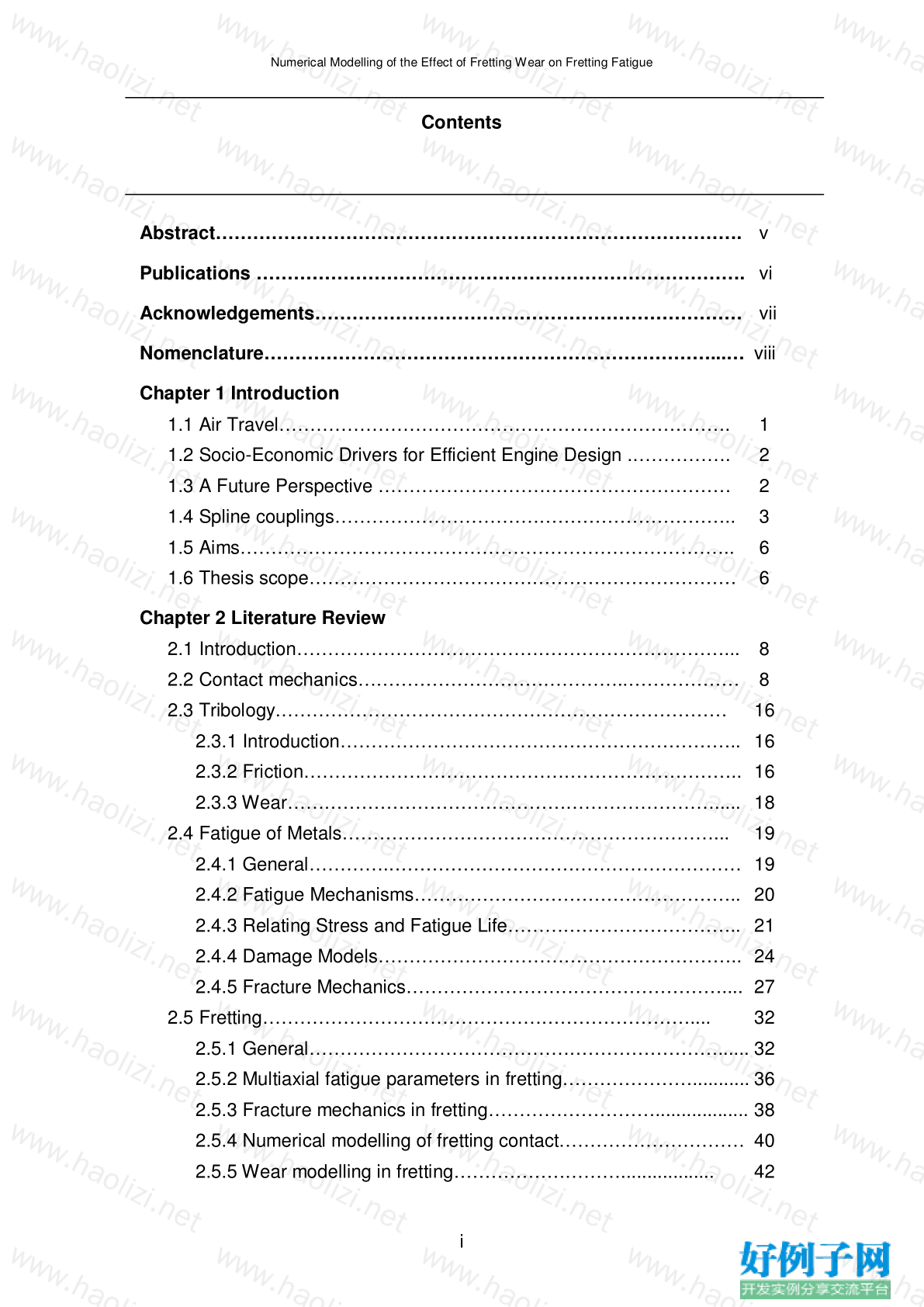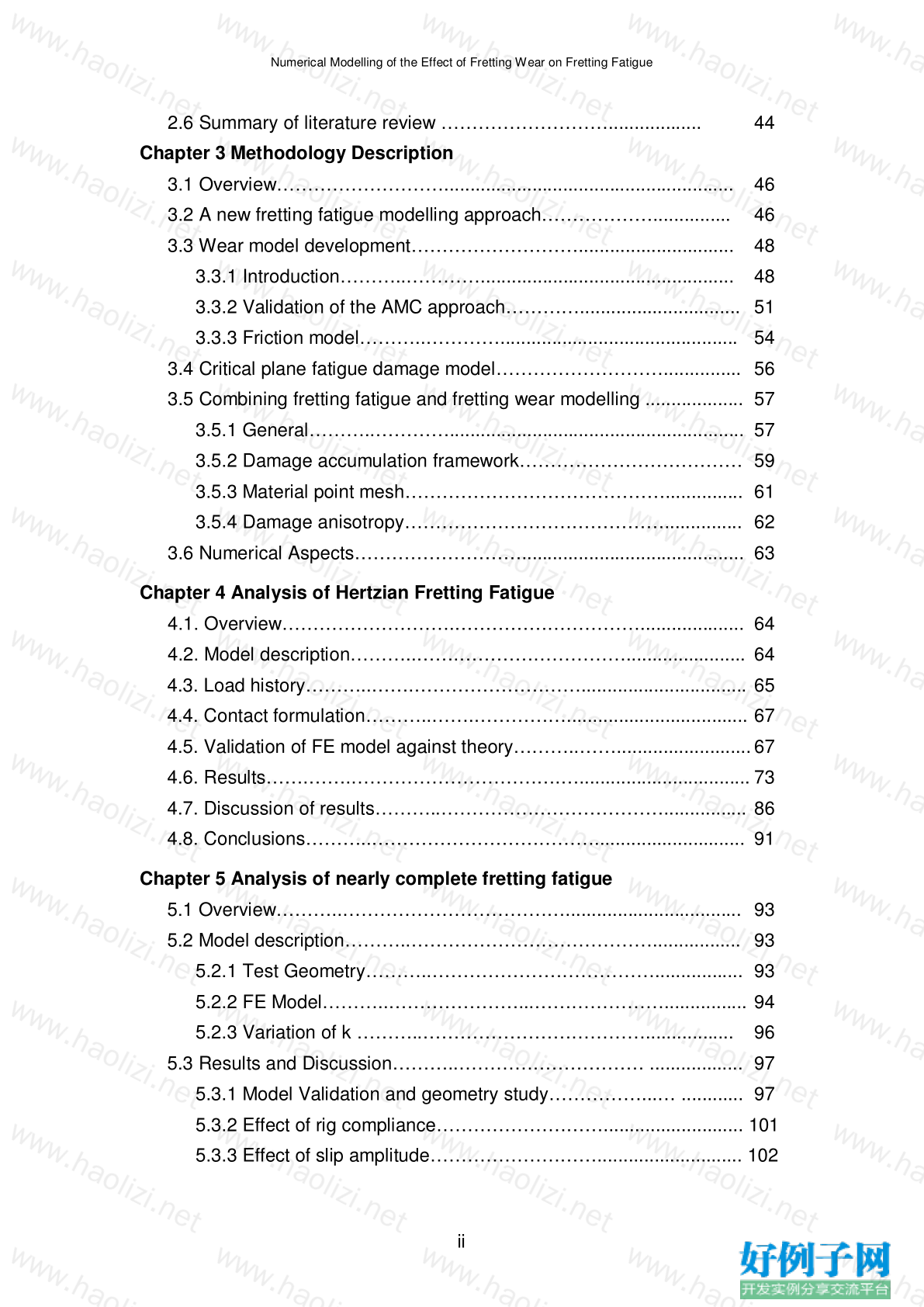实例介绍
【实例截图】





【核心代码】
Contents
Abstract…………………………………………………………………………. v
Publications ……………………………………………………………………. vi
Acknowledgements…………………………………………………………… vii
Nomenclature………………………………………………………………...… viii
Chapter 1 Introduction
1.1 Air Travel………………………………………………………………. 1
1.2 Socio-Economic Drivers for Efficient Engine Design .……………. 2
1.3 A Future Perspective ………………………………………………… 2
1.4 Spline couplings……………………………………………………….. 3
1.5 Aims…………………………………………………………………….. 6
1.6 Thesis scope…………………………………………………………… 6
Chapter 2 Literature Review
2.1 Introduction……………………………………………………………... 8
2.2 Contact mechanics……………………………………..……………… 8
2.3 Tribology.……………………………………………………………… 16
2.3.1 Introduction……………………………………………………….. 16
2.3.2 Friction…………………………………………………………….. 16
2.3.3 Wear……………………………………………………………..... 18
2.4 Fatigue of Metals……………………………………………………... 19
2.4.1 General………….………………………………………………… 19
2.4.2 Fatigue Mechanisms…………………………………………….. 20
2.4.3 Relating Stress and Fatigue Life……………………………….. 21
2.4.4 Damage Models………………………………………………….. 24
2.4.5 Fracture Mechanics…………………………………………….... 27
2.5 Fretting…………………………………………………………….... 32
2.5.1 General…………………………………………………………...... 32
2.5.2 Multiaxial fatigue parameters in fretting…………………........... 36
2.5.3 Fracture mechanics in fretting……………………….................. 38
2.5.4 Numerical modelling of fretting contact………………………… 40
2.5.5 Wear modelling in fretting……………………….................. 42
Numerical Modelling of the Effect of Fretting Wear on Fretting Fatigue
ii
2.6 Summary of literature review ……………………….................. 44
Chapter 3 Methodology Description
3.1 Overview………………………........................................................ 46
3.2 A new fretting fatigue modelling approach………………............... 46
3.3 Wear model development……………………….............................. 48
3.3.1 Introduction………..…………................................................. 48
3.3.2 Validation of the AMC approach…………............................... 51
3.3.3 Friction model………..………….............................................. 54
3.4 Critical plane fatigue damage model………………………............... 56
3.5 Combining fretting fatigue and fretting wear modelling ................... 57
3.5.1 General………..…………......................................................... 57
3.5.2 Damage accumulation framework……………………………… 59
3.5.3 Material point mesh……………………………………............... 61
3.5.4 Damage anisotropy……………………………………............... 62
3.6 Numerical Aspects………………………........................................... 63
Chapter 4 Analysis of Hertzian Fretting Fatigue
4.1. Overview……………………….………………………….................... 64
4.2. Model description………..…….………………………....................... 64
4.3. Load history………..…….………………………................................ 65
4.4. Contact formulation………..…….……………................................... 67
4.5. Validation of FE model against theory………..…….......................... 67
4.6. Results…….…….…………………………….…................................. 73
4.7. Discussion of results………..………………………………................ 86
4.8. Conclusions………..………………………………............................. 91
Chapter 5 Analysis of nearly complete fretting fatigue
5.1 Overview………..……………………………….................................. 93
5.2 Model description………..…………………………………................. 93
5.2.1 Test Geometry………..………………………………................. 93
5.2.2 FE Model………..…………………...…………………................ 94
5.2.3 Variation of k ………..………………………………................. 96
5.3 Results and Discussion………..………………………… .................. 97
5.3.1 Model Validation and geometry study……………...… ............ 97
5.3.2 Effect of rig compliance………………………........................... 101
5.3.3 Effect of slip amplitude………………………............................ 102
Numerical Modelling of the Effect of Fretting Wear on Fretting Fatigue
iii
5.3.4 Effect of wear: Gross sliding……………….….......................... 104
5.3.5 Effect of wear: Partial slip…………………..….......................... 106
5.3.6 Effect of wear coefficient on fretting fatigue behaviour …........ 109
5.4 Conclusions………..……………….................................................... 113
Chapter 6 A Combined Fracture Mechanics and Wear Modelling Method
6.1 Introduction………..……………........................................................ 115
6.2 Damage tolerant approach…………………..…................................ 115
6.3 Methodology………..….………......................................................... 118
6.4 Crack growth………..….………........................................................ 119
6.5 Finite element modelling………........................................................ 122
6.5.1 Global-sub model approach…………………..…...................... 122
6.5.2 Mesh generation ………………………..……..…...................... 125
6.5.3 Stress intensity factor determination……………………........... 125
6.6 Combining critical plane and LEFM approaches……………............ 130
6.7 Contact stress evolution treatment…………………………............... 131
Chapter 7 Effect of wear on crack growth behaviour
7.1 Introduction………..….………........................................................... 133
7.2 Results………..….……….................................................................. 133
7.2.1 Comparison with test data…………………….………............... 133
7.2.2 Effect of nucleation period…………………….………............... 134
7.2.3 Effect of bulk stress: crack arrest…………………….…............ 139
7.3 Discussion …………………….…………………………….................. 143
7.4 Conclusions …………………………………………….…................... 148
Chapter 8 Fretting analysis of a tapered rotor joint
8.1 Overview ………………………………………….….…....................... 151
8.2 Torque couplings……………………………………….…................... 151
8.2.1 Taper couplings ……………………………………….…............ 151
8.2.2 Conic Coupling …………………………………………………… 152
8.3 Model description ………………………………………………………. 153
8.4 Results …………………………………………………………………... 157
8.4.1 Fretting wear study ………………………………………………. 157
8.4.2 Design optimisation ……………………………………………… 159
8.5 Conclusions ………………………………………………………….…. 161
Numerical Modelling of the Effect of Fretting Wear on Fretting Fatigue
iv
Chapter 9
9.1 Conclusions……………………………………………………………… 162
Chapter 10 Recommendations and further work
10.1 Overview ………………………………………………………..……... 164
10.2 Method improvements ……………………………………………….. 164
10.2.1 Tribology Model .……………………………………………..…. 164
10.2.2 Friction Model Improvements …………………………………. 165
10.2.3 Wear Model Improvements ……………………………………..165
10.3 Fatigue Model ……………………………………………………….....167
10.3.1 General …………………………………………………….......…167
10.3.2 Damage accumulation assumption ……………….......……... 168
10.4 Other areas of application .……………….............................……... 169
10.4.1 Engineering assemblies ……………………………......……... 169
10.4.2 Materials ……………….......……... ……………….......…….....169
10.4.3 Coatings ……………………………......……………………….. 170
Appendix A1 Abaqus Subroutine
A1.1 Overview …………………………….....……………………………... 171
A1.2 Code ………………………......……...……………………………..... 172
Appendix A2 Verification of Numerical Aspects
A2.1 Overview ………………….....……………………………................. 176
A2.2 Effect of cycle jumping ………………….....……………………...…. 176
A2.3 Effect of increment size ………………….....…..…………….……... 181
A2.4 Mesh refinement ………………….....……………...…………..……. 185
A2.5 Stress reporting location …………………..………...………………. 189
Appendix A3 Effect of rig compliance
A3.1 Overview ………………….....………………………...….………... 192
A3.2 Initial geometry …………….....……………………….………….... 192
References...……………………….....………………………..…..…………... 198
umesNumerical Modelling of the Effect of Fretting Wear on Fretting Fatigue
小贴士
感谢您为本站写下的评论,您的评论对其它用户来说具有重要的参考价值,所以请认真填写。
- 类似“顶”、“沙发”之类没有营养的文字,对勤劳贡献的楼主来说是令人沮丧的反馈信息。
- 相信您也不想看到一排文字/表情墙,所以请不要反馈意义不大的重复字符,也请尽量不要纯表情的回复。
- 提问之前请再仔细看一遍楼主的说明,或许是您遗漏了。
- 请勿到处挖坑绊人、招贴广告。既占空间让人厌烦,又没人会搭理,于人于己都无利。
关于好例子网
本站旨在为广大IT学习爱好者提供一个非营利性互相学习交流分享平台。本站所有资源都可以被免费获取学习研究。本站资源来自网友分享,对搜索内容的合法性不具有预见性、识别性、控制性,仅供学习研究,请务必在下载后24小时内给予删除,不得用于其他任何用途,否则后果自负。基于互联网的特殊性,平台无法对用户传输的作品、信息、内容的权属或合法性、安全性、合规性、真实性、科学性、完整权、有效性等进行实质审查;无论平台是否已进行审查,用户均应自行承担因其传输的作品、信息、内容而可能或已经产生的侵权或权属纠纷等法律责任。本站所有资源不代表本站的观点或立场,基于网友分享,根据中国法律《信息网络传播权保护条例》第二十二与二十三条之规定,若资源存在侵权或相关问题请联系本站客服人员,点此联系我们。关于更多版权及免责申明参见 版权及免责申明



网友评论
我要评论